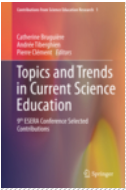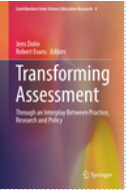ESERA Book Series
Publications







All books in the Series are available to ESERA members. Please see below for details.
Contributions from Science Education Research
Contributions from Science Education Research is the international, multidisciplinary book series of the European Science Education Research Association (ESERA). The series is published under the imprint of an established publishing house (Springer) but also carries the ESERA logo.
The aim of the series is to enhance the quality and impact of research in science education in Europe. To achieve this, books present and discuss, for the benefit of the scholarly community and other users of research, the findings of high-quality research in the domain of science education and in-depth explorations of specific methodological strands in science education research. The series aims to publish books that are innovative in the issues they explore, or the methods they use, or the ways in which emergent knowledge in the field is represented. It includes edited collections of chapters on a specific theme, monographs and handbooks.
The ESERA book series focuses primarily on research carried out in Europe. However, contributions from researchers affiliated with non-European institutions and non-members of the European Science Education Research Association are also welcomed.
ESERA is currently organized into 19 strands and the intention is to offer a publication forum that appeals to all these research domains.
The procedure for proposing a book for the ESERA series, and for supporting the development of accepted proposals, follows that which is used by Springer for general book proposals. The advantage to authors of seeking to publish in the ESERA series is that their book will be available to ESERA members and will be actively marketed at ESERA and other conferences – both leading to many more people reading it. The editorial contract for the ESERA book series is under negotiation, updated conditions will be published as soon as it is finalised.
Prospective authors of monographs or editors of thematic collections of chapters should submit proposals to the Editor-in-Chief for consideration by the Editorial Board (see below).
The author(s)/editor(s) will submit a proposal by downloading and completing a Book proposal Form.
We envisage a manuscript length of between 200 and 250 pages (c. 100,000 and c. 140,000 words), but proposals for books outside this range will also be considered.
The proposal will be reviewed by at least three members of the Editorial Board. Each will send a report and recommendation to the Editor-in-Chief who will make the final decision on the proposal:
• accept without change
• accept with minor revision
• accept subject to major revision
• reject
The decision will be communicated to the author(s)/editor(s) of the proposed book by the Editor-in-Chief, with a decision letter explaining the rationale for the decision of the Editorial Board. If major revisions are requested, the proposal will be reviewed by the Editorial Board afresh; where possible, the same members of the Editorial Board will review the re-submission.
Once a book proposal has been accepted by the Editorial Board, all subsequent correspondence with the Editorial Board should be sent to the Editor-in-Chief of the ESERA Book Series. From this point onwards, the main function of the Editorial Board is to support the author(s)/editors(s) in producing a final manuscript of high quality.
For all manuscripts:
The format of the book manuscript should be consistent with the guidelines set by the publisher (writing style, bibliography style, spacing, etc.).
Springer’s manuscript preparation instructions and template can be found on this dedicated web page: https://www.springer.com/gp/authors-editors/book-authors-editors/manuscript-preparation/5636
You can also download an Author word template, as well as the instructions on its use. (use of this template is optional):
• Download Author word template
• Download Author word template instructions
Book author(s)/editor(s) should submit the final book manuscript in electronic form to the Editor-in-Chief.
The detailed procedure for the review of the book manuscript is set out below.
For an authored book (a monograph):
1. The author(s) will propose to the Editorial Board two reviewers for the whole book. The Editorial Board will also draw up a list of suitable reviewers. In consultation with Springer, the Editor-in-Chief will agree on reviewers (usually three) who will be approached by Springer and asked to undertake this task.
2. These reviewers will evaluate the manuscript and send reports to Springer who will share them with the Editor-in-Chief. Each review will include a recommendation: accept without change/accept with minor revision/accept with major revision/reject. Springer will send anonymised copies of these reports to the author(s).
3. If minor revision is recommended, the author(s) will amend the manuscript at their own discretion.
4. If major revision is recommended, the author(s) will send to the Editor-in-Chief a report outlining the steps they propose to take to amend the manuscript. These should be agreed by the Editorial Board before proceeding.
The revised manuscript will be sent to reviewers (ideally those who reviewed the original manuscript), who will send reports to Springer (and hence to the Editor-in-Chief) with a recommendation: accept without change/accept with minor revision/reject. These will again be sent (anonymised) to the author(s).
If further minor revision is recommended, this is at the discretion of the author(s).
For an edited book:
• The editor(s) of the book will propose two reviewers for each chapter. The Editorial Board will review these proposals and reach agreement with the book editors on chapter reviewers.
• Reviewers will evaluate the chapter assigned to them and send a report to the editor(s) of the book with a recommendation: accept without change/accept with minor revision/accept with major revision/reject.
• The editor(s) note the recommendations of chapter reviewers, communicate reviewers’ comments to chapter authors, and advise authors on the actions required.
• If a chapter requires minor revisions, acceptance of the revised chapter is at the discretion of the editor(s) of the book.
• If a chapter requires major revisions, the revised chapter should be sent to the same chapter reviewers for comment and recommendation: accept without change/accept with minor revision/reject.
• Final decisions on chapters are taken by the book editor(s). All documentation generated during this review process should be retained and sent to the Editor-in-Chief along with the book manuscript.
Manuela Welzel-Breuer, Series Editor: welzel@ph-heidelberg.de
We anticipate that, if the procedures above have been followed, the evaluation by the Editorial Board of a submitted manuscript will be carried out quickly. The procedure for reaching a decision about a submitted book manuscript is as follows:
• The Editor-in-Chief checks that the review procedure was followed and therefore the high quality of the manuscript can be documented. If there are any concerns about this documentation, the Editor-in-Chief will seek the advice of members of the Editorial Board.
• The Editor-in-Chief reports on this evaluation process to the Editorial Board and makes a recommendation on publication.
• When a decision has been reached by the Editorial Board, this will be conveyed to the author(s)/editor(s) by the Editor-in-Chief.
• If the decision is positive, the Editor-in-Chief will contact the publishers, who will be in touch with the book author(s)/editor(s) about publication procedures.
Each author of an authored book, and each editor of an edited book, will receive three paper copies of the book.
Each chapter author of an edited book will receive one paper copy of the book.
ESERA members will be able to order paper copies of all books in the Series for a discounted ESERA member price of EUR 19,95 (excl. VAT and shipping) and download the eBook for EUR 7,50 (excl. VAT). An order can be placed via the Springer website by using the discount code ESERA for print and ESERAe for eBook.
ESERA members are also able to have a 20% discount code for other science education books by Springer.
• The Editor-in-Chief checks that the review procedure was followed and therefore the high quality of the manuscript can be documented. If there are any concerns about this documentation, the Editor-in-Chief will seek the advice of members of the Editorial Board.
• The Editor-in-Chief reports on this evaluation process to the Editorial Board and makes a recommendation on publication.
• When a decision has been reached by the Editorial Board, this will be conveyed to the author(s)/editor(s) by the Editor-in-Chief.
• If the decision is positive, the Editor-in-Chief will contact the publishers, who will be in touch with the book author(s)/editor(s) about publication procedures.
The Editorial Board consists of an Editor-in-Chief and six to seven Editorial Board Members. The Board is appointed by the ESERA Executive Board once every four years. To ensure continuity, the next Editor-in-Chief will always be selected from the existing Editorial Board Members. To ensure renewal, (a) at least three of the members of the Editorial Board will be replaced every four years, and (b) the Editor-in-Chief will change every four years. No member of the Editorial Board can serve for more than three terms, including any time as Editor-in-Chief.
The work on all book proposals and books submitted to an Editorial Board will be completed by that same Board.
The current Editorial Board is made up of the ESERA President, five ESERA Past Presidents and four active members who are established researchers in science education:
- Manuela Welzel-Breuer, University of Education Heidelberg, Germany (2021-)
- Costas Constantinou, Professor, University of Cyprus, Cyprus (2013 – )
- Niklas Gericke, Karlstad University, Sweden (2021-)
- Olivia Levrini, University of Bologna, Italy (2021-)
- Isabel Martins, Federal University of Rio de Janeiro, Brazil (2021-)
- Sonya Martin, Seoul National University, South Korea
- Robin Millar, University of York, UK
- Iva Stuchlikova, University of South Bohemia, Czech Republic (2017-)
- Veli-Matti Vesterinen, University of Turku, Finland (2018-)
- Albert Zeyer, University of Teacher Education Lucerne, Switzerland (2017-)
